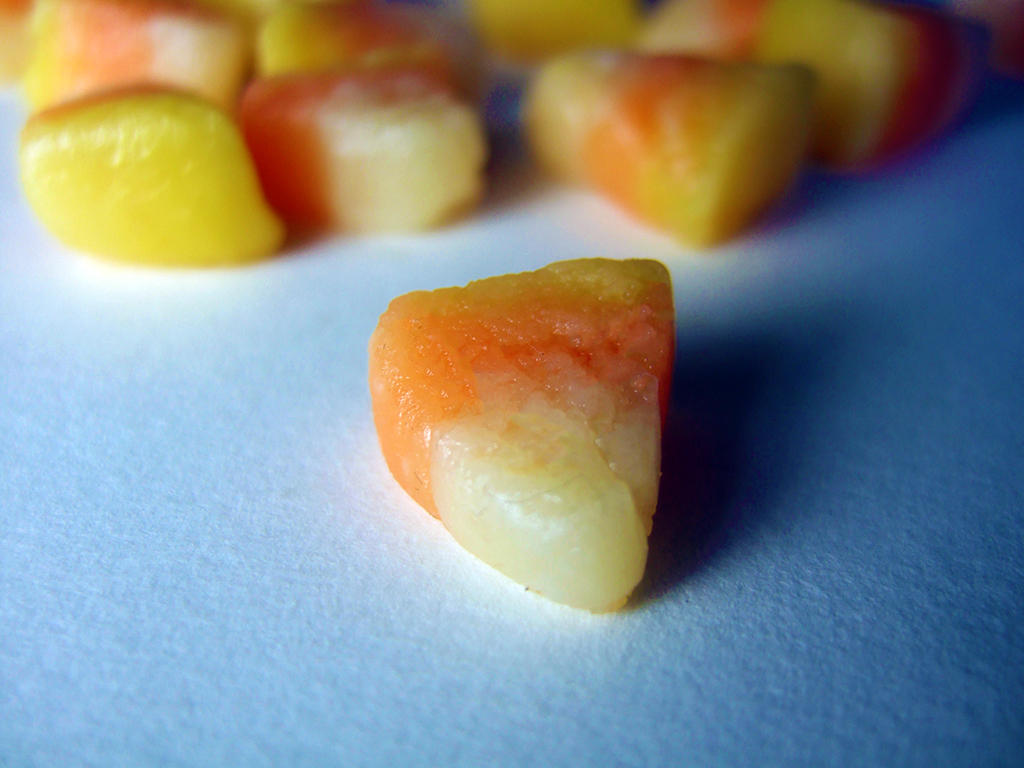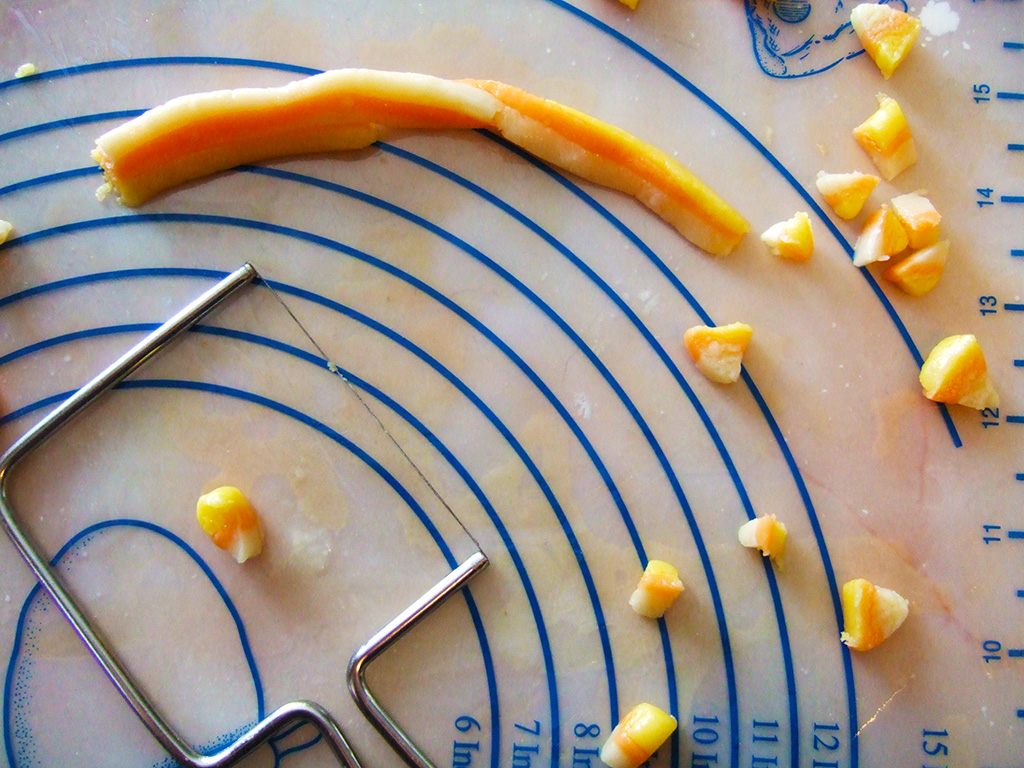 A handmade candy corn.
A handmade candy corn.
I was recently charged with the task of coming up with a hands-on food activity for the New York Historical Society’s Halloween bash, so I’ve been thinking a lot on the origins of Halloween candy. Â One of the first treats to spring to my mind is also the first candy to be associated with the holiday, the much maligned Candy Corn.
The celebration Halloween became popular right at the end of the 19th century and into the early 20th. Â Theme parties were all the rage, so you could expect to head over to a friend’s (with the kids or not) for spooky decorations and refreshments. Â The Book of Hallowe’en, published in 1919, gives us a sense of what these parties were like:
For the centerpiece of the table there may be a hollowed pumpkin, filled with apples and nuts and other fruits of harvest, or a pumpkin-chariot drawn by field-mice… Jack-o’-lanterns, with which the room is lighted, are hollowed pumpkins with candles inside… Corn-stalks from the garden stand in clumps about the room. A frieze of witches on broomsticks, with cats, bats, and owls surmounts the fireplace, perhaps…The prevailing colors are yellow and black: a deep yellow is the color of most ripe grain and fruit; black stands for black magic and demoniac influence.
Having marched to the dining-room to the time of a dirge, the guests find before them plain, hearty fare; doughnuts, gingerbread, cider, popcorn, apples, and nuts honored by time. The Hallowe’en cake has held the place of honor since the beginning here in America. A ring, key, thimble, penny, and button baked in it foretell respectively speedy marriage, a journey, spinsterhood, wealth, and bachelorhood.
Along side the bowls of party nuts, you were also likely to find a dish of candy corn. Created around 1880, candy corn was not considered a seasonal sweet.  Better known at the time as “chicken feed,” which I think is a very cute name, it was  manufactured year round and was especially popular for the Fourth of July and in Easter baskets. But with its harvest-festival colors of yellow, orange and red it also seemed a natural fit for fall celebrations, and was slowly integrated into Halloween parties. From The Atlantic:
Candy-making oral tradition credits the invention of candy corn to George Renninger, a candy maker at the Wunderle Candy Company of Philadelphia…At that time, many candy makers were producing “butter cream” candies molded into all kinds of natural or plant-inspired shapes, including chestnuts, turnips, and clover leaves. The real innovation in candy corn was the layering of three colors. This made it taxing to produce (all those colors had to be layered by hand in those days). But the bright, layered colors also made the candy novel and visually exciting.

It seems ridiculous that a candy-consuming holiday was invented when Halloween is RIGHT THERE, but it wasn’t really until after WWII, when sugar rationing was lifted, that candy companies finally caught on to the appeal, and started manufacturing Halloween themed candy in appropriate Jack-o-Lantern shapes, fall colors, and fun sizes. Conversely, Brach’s, established in 1904, is now doing its best to detach candy corn from its Halloween-only image, by producing new flavors like “Milk Maid Caramel Candy Corn” and manufacturing different seasonal colors like red & green
.
 Slicing up the candy corns with my Velveeta Cheese Slicer. Handy!
Slicing up the candy corns with my Velveeta Cheese Slicer. Handy!
I’ve never liked candy corn, but I decided to give them a second chance after I stumbled across Alton Brown’s recipe for “chicken feed” from scratch. It blends butter and powdered milk (I used Bob’s Red Mill Non-Fat Dry Milk Powder; is it weird that I love the way powdered milk tastes?) with boiled sugar. There is a bit of a learning curve with this recipe: the first time I made it, the dough turned out unusable, flaky, and weird. The second time, I was more precise: I measure my ingredients by weight instead of volume and boiled the sugar at a lower temperature. Round two was much better, and although my candy corns (pictured above) turned out looking very handmade, I find them endearing. And they taste waaay better than store-bought: they have a creaminess and tartness, a sweet and saltyness, an overall complexity of flavor that can only come from handmade.

So interesting! Candy corn was in the realm of things I can’t make myself, or so I thought! Great post.
They may fall into the category of “why would i want to make these myself?” but I was actually surprised by how tasty they are. Plus, I think it would be a great project for kids.
Hi,
I just love your blog. I’ve always been fascinated with old cookbooks. I love imagining the way people used to live, and cookbooks give such a unique view of different times. Anyway, I think your homemade “chicken feed” is beautiful!
Cara
aw,thank you! I love all those things, too! And the chicken feed is pretty darn tasty.
It figures that candy corn originated from Philadelphia! A lot of weird foods, like Scrapple and Pepper Pot Soup, come from there.